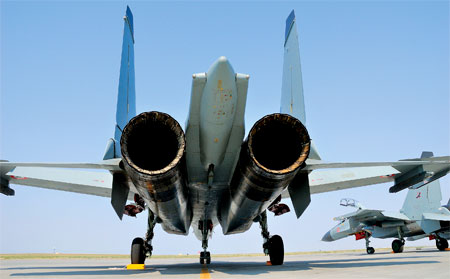INDIAN ARMED FORCES CHIEFS ON OUR RELENTLESS AND FOCUSED PUBLISHING EFFORTS

The insightful articles, inspiring narrations and analytical perspectives presented by the Editorial Team, establish an alluring connect with the reader. My compliments and best wishes to SP Guide Publications.

"Over the past 60 years, the growth of SP Guide Publications has mirrored the rising stature of Indian Navy. Its well-researched and informative magazines on Defence and Aerospace sector have served to shape an educated opinion of our military personnel, policy makers and the public alike. I wish SP's Publication team continued success, fair winds and following seas in all future endeavour!"

Since, its inception in 1964, SP Guide Publications has consistently demonstrated commitment to high-quality journalism in the aerospace and defence sectors, earning a well-deserved reputation as Asia's largest media house in this domain. I wish SP Guide Publications continued success in its pursuit of excellence.
- The layered Air Defence systems that worked superbly, the key element of Operation Sindoor
- Operation Sindoor | Day 2 DGMOs Briefing
- Operation Sindoor: Resolute yet Restrained
- India's Operation Sindoor Sends a Clear Message to Terror and the World – ‘ZERO TOLERANCE’
- Japan and India set forth a defence cooperation consultancy framework, talks on tank and jet engines
SU-30MKI ...but also Gained in The Bargain

In the Su-30MKI, the IAF got A Formidable Multi-Role Strike Platform. Therefore, rumoured geopolitical and strategic compulsions notwithstanding, it was perhaps not a bad buy
That India acquiesced to buy the Su-30 jet fighters from Russia considering Moscow was its trusted friend and strategic partner for many decades may indeed be partly true, but that’s not the whole story. In the early 1990s, Russia was going through cataclysmic politico-economic transformation wherein the monolith empire of the communist USSR lay shattered. Surviving entity, the Russian Federation’s economy was almost in ruins and the erstwhile flourishing Russian military aviation industry was on the brink of collapse, with no fresh orders coming from even its own air force let alone foreign customers.
Against this backdrop, an Indian defence delegation headed for Russia in 1994 and had the first glimpse of the Su-30 at Sukhoi’s Siberia-based world famous ‘Irkut’ military aviation plant. It was not the sheer size which impressed the visitors but the vast potential for improvement in the aircraft’s operational capabilities. Two years of further evaluation and negotiations later, India decided to purchase Su-30s from Russia. On November 30, 1996, India signed a $1.462 billion (Rs 7,155 crore) deal with the Sukhoi Corporation for the delivery of 50 Su-30 aircraft. But it was not a straightforward, off-theshelf purchase. The aircraft were to be delivered in five batches with incremental improvements in performance and operational capabilities. The highly intricate and laborious sets of hased modifications/additions ultimately produced the most refined version now known as the Su-30MKI (‘I’ for India).
Meanwhile, India had in 2000 signed another deal with Russia for the indigenous manufacture of 140 of these jets by Hindustan Aeronautics Limited (HAL). The first fully matured MKI entered service with the Indian Air Force (IAF) in 2004 and in 2007, a further order of 40 jets was placed with Russia. At present, approximately 100 Su-30MKIs are under active service in five combat squadrons of the IAF. The final version of Su-30MKI featured many ability enhancing modifications over the basic Su-27 and the Su-30MK from which it was derived. These included canard foreplanes, two-dimensional thrustvectoring control, Russian-made NO11-M passive phased array radar (PESA) and a range of avionics complex sourced from Russia, France, Israel and India, which includes display, navigation, targeting and electronic warfare systems. Unconfirmed reports suggest that the more advanced PESA radar Irbis-E might be added to the jet fighter by 2010, when the first fully India-built Su-30MKI rolls out from HAL, Nasik.
The Su-30MKI’s three-plane aerodynamic unstable configuration, coupled with thrust-vectoring, results in extremely agile manoeuvrability allowing deployment of weapons in any desired direction. The forward facing NIIP NO11-M Bars (Panther) is a powerful PESA multi-functional radar with long range detection/multi-tracking capabilities which, with onboard beyond visual range air-to-air missiles, can beat most of the existing aerial threats. In the air-to-ground role, integration of the Israeli Litening Targeting Pod along with the indigenous 1,000 lb bombs with laser-guided bomb kits has lent the aircraft multi-role precision-strike capability. In addition, a modified Su-30MKI is being developed to carry Indo-Russian BrahMos supersonic cruise missiles, with planned induction in 2012. For Electronic Warfare (EW), the MKI has an indigenous system called ‘Tarang’, with a programmable threat library and direction finding capability. It also carries the potent and powerful Israeli Elta EL/M-8222 self-protection EW pod.





